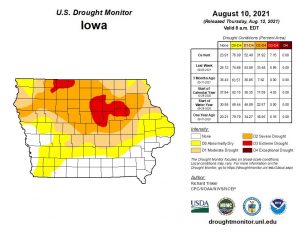CLICK HERE for the latest market quotes from the Iowa Agribusiness Network!
CLICK HERE for the latest market quotes from the Brownfield Ag News Network!
CLICK HERE for the latest market quotes from the Iowa Agribusiness Network!
CLICK HERE for the latest market quotes from the Brownfield Ag News Network!
(Radio Iowa) – People were lined up to get into the Iowa State Fairgrounds Thursday as the event returned from the pandemic layoff.The fairgoers were anxious to get back to the familiar sights, sounds, and tastes of the fair. And everyone had the same opinion on the year without it — one woman saying it “was kind of a bummer.” Denny Reichardt of Corning says last year was “bad, but safe.” He and his wife Betsy had been to the Iowa State Fair for some 30 years straight before last year’s cancellation.
Reichardt says everyone appeared as anxious as they were to get in. He says they ended up waiting on Grand Avenue to get in and cars were backed up about a quarter-mile. They like to get to the fair early and on opening day. “Absolutely, we are first-dayers all along,” Denny says. Betsy was asked what her favorite thing is to do at the fair and she responded “Just look.”

ISF Grand Concourse
Denny says their strategy is to get there early and leave after lunch before things get too hot.
(Radio Iowa) – People flowed into the gates when they opened this (Thursday) morning as the Iowa State Fair returned after being canceled in 2020 by the pandemic. Fair C-E-O Gary Slater spoke at the opening ceremonies. “I can tell you it was a hard 14 months, but we weren’t sure we would be here today — but we are resilient, we are resourceful, and I can confidently say that we are back,” Slater says. Governor Kim Reynolds also spoke.”Yeaah, welcome back to the Iowa State Fair,” she says. The governor was cheered and told the crowd she has already taken several steps and is counting them to be sure she gets enough exercise to offset anything she eats. “I am tracking my way so I can eat the rest of the afternoon. It is a strategy that we all should be taking,” Reynolds says.
She spoke with Radio Iowa after the opening ceremonies and says she expects huge crowds during the 11-day run. “It’s so exciting, it’s just a tradition that families look forward to every year and generations of families,” according to Reynolds. “And it’s not just in Iowa, it’s all across the country and really around the world. People know about the Iowa State Fair and they really look forward to coming,” she says. Some critics says the State Fair brings too many maskless people together and risks the spread of COVID. “We did RAGBRAI and we did Hinterland that had thousands and thousands of people and I didn’t see a lot of masks there. We need to do it safely and responsibly — Iowans are doing that,” according to Reynolds.

Gov. Kim Reynolds at the 2021 Iowa State Fair
COVID case numbers have gone back up — as have hospitalizations — but Reynolds says this is not the same as the height of the pandemic. “You have to put it in context though of what we saw back in December and November when we actually peaked. At that time, probably 37 percent of our hospitalizations were COVID-related. And I actually had hospitals reaching out and saying we are on the brink and we are afraid if something would happen we wouldn’t have the capacity to take it.” Reynolds says the current infection rate is still well below the peak. “We’re not even at three percent right now — so yeah they’re rising — but the difference between then and now is we have a vaccine,” Reynolds says. “And the deal with the vaccine is that it prevents people for the most part being hospitalized or death. We are not seeing it correlate to the deaths like we did.”
She says that’s especially true among the elderly population.
(Radio Iowa) – The trillion-dollar infrastructure bill that passed the U-S Senate this week contained nothing for biofuels but did include more than seven-billion dollars in funding for a charger network for electric vehicles, or E-Vs. Cassidy Walter, spokeswoman for the Iowa Renewable Fuels Association, says the Senate missed a tremendous carbon reduction opportunity. Walter says, “If our country is trying to reduce carbon emissions by having a singular focus on EVs, we’re really setting aside the huge impact that biofuels are prepared to make.”
The biofuels industry is already making great leaps, Walter says, toward being more planet-friendly. “Today, they’re reducing carbon emissions by roughly 50% or more already and they’re on a path to be carbon negative in the next decade,” Walter says. “It’s a missed opportunity that’s actually worse for our environment, it’s no good for the Midwestern economy and it hurts farmers.” The bill has headed to the U-S House where Walter says her organization will be lobbying members of Iowa’s congressional delegation to include biofuels. “There is a lot of room for biofuels to grow when it comes to infrastructure,” Walter says. “We have a long way to go in terms of increasing consumer access to higher biofuel blends like E-15, E-85 and B-20.”
Walter says it’s critical Congress embrace multiple solutions to the nation’s environmental challenges instead of following a one-size-fits-all approach as the Senate did.
Cass and parts of surrounding counties are still experiencing drought conditions. The latest Drought Monitor released today (Thursday), indicates all of Cass, Adair, and Mills Counties are Abnormally Dry. Most of Audubon and Madison Counties are also Abnormally Dry, with a section of Guthrie and most of Dallas County in a Moderate Drought. Other counties in the area experiencing abnormally dry soil conditions include: the eastern half of Pott. County; the southeastern part of Shelby County; the northwestern half of Adams County; and about two-thirds of Fremont and Page Counties.
Extreme Drought continues to plague all or parts of 11 counties in northeastern Iowa, and parts of five northwest/central Iowa, closest to the Minnesota border.

The Drought Monitor map released 8/12/21
THAYER, Iowa—Officials with the Iowa Department of Natural Resources report DNR staff, Tuesday, investigated cleanup of a manure spill about six miles south of Thayer, in Union County. Iowa Select Farms had reported the spill Monday night, after pumping manure into a nearly full manure storage tank at one of their sow facilities. Their staff said the manure was supposed to be pumped into a different tank, but someone left a valve closed. Iowa Select estimated between 10,000 and 20,000 gallons spilled over the side of the tank into a small tributary of the Grand River. Tuesday, they updated the amount to about 10,000 gallons.
DNR staff confirmed Iowa Select had dammed the tributary, trapping pooled liquid behind the dam, preventing a fish kill in the Grand River. Iowa Select is working with DNR to pump manure from the pool and land apply it at fertilizer rates. DNR field tests showed elevated ammonia levels behind Iowa Select’s dam. Field tests also indicated there was no impact to the Grand River.
The tributary was too small to support fish and DNR staff found no dead fish in the Grand River. They will continue to monitor cleanup activities. DNR will consider appropriate enforcement action.
(Radio Iowa) – The non-profit group Practical Farmers of Iowa is launching a new smartphone application designed to make it easy for farmers to make decisions about cover crops in time for fall planting. Sarah Carlson, P-F-I’s strategic initiatives director, says the free app, called Find Cover Crops, aims to be a helpful resource and a time-saver. “Farmers can search with geolocation cover crop business services that are nearby their farm,” Carlson says. “So if you need somebody to custom drill, if you need to find an aerial applicator, or if you need to find seed or any other cover crop services, you can find those locations, find those businesses, reach out to them and hire their services.”
The app also offers embedded how-to videos for seeding, grazing and terminating cover crops, in addition to showing farmers how to precisely identify the boundaries of fields to be cover cropped. The app is free to download via the Apple App Store and the Google Play Store. Perhaps one in ten Iowa farmers have planted cover crops in the past decade, and Carlson says many more need to — but don’t — due to time management issues and logistics. “The number-one reason why we need to use them in the state is to improve our water quality so that we can avoid potential future regulation and hold that nitrogen on our fields,” Carlson says. “And then we see other farmers finding a lot of weed control benefits from cover crops, some are even able to cut herbicides which then basically pays for the cover crop.” 
All sorts of things can be planted as cover crops, but Carlson says cereal rye is the most popular and versatile, as it can be planted into late December. “And then normally putting cereal rye ahead of that next year’s soybean crop, that’s the most common use of cover crops today,” Carlson says. “Honestly, it’s the least risk, it’s the best benefit because soybeans benefit yieldwise after that rye cover crop, and we get improved weed control, reduced erosion, better water quality.”
Privately-funded cost share programs for cover crops are available through the Practical Farmers’ website which Carlson says may bring between ten and 40 dollar per acre, making the practice essentially risk-free. Learn more at: practicalfarmers.org.
(Iowa DNR News) – Conservation Officers in Iowa have concluded a six-month-long investigation into felony weapons charges and wildlife poaching violations involving a deer hunting party in Johnson and Linn counties. The case began with a TIP (Turn in Poachers) call to conservation officers about a buck deer that was unlawfully shot from the roadway onto private property in northern Johnson County in December 2020. The ensuing investigation uncovered a variety of deer poaching violations that occurred over several years. Multiple violations occurred in 2020 including: hunting out of season, hunting without proper licenses, wanton waste of wildlife, overlimiting, unlawful method of take, tagging and reporting violations, illegal waterfowl hunting, and felon in possession of a firearm. 
The case resulted in a total of one felony weapons charge, 57 hunting related charges, and multiple written warnings to a hunting group made up of four individuals.
Larry Jones (of Cedar Rapids), a convicted felon, pleaded guilty to 10 hunting related charges and is awaiting trial for a felony weapons charge in Linn County. Jones faces 30 additional hunting related charges in Johnson County and is currently awaiting trial. Steve Sinnett (of Swisher), pleaded guilty to 13 hunting related charges in Johnson County. Tania Holdren (of Cedar Rapids) pleaded guilty to four deer hunting charges in Johnson County. Shane Yarrington (Cedar Rapids) pleaded guilty to one deer hunting charge in Johnson County.
Iowa DNR conservation officers encourage the public to continue to use the Turn In Poachers hotline (1-800-532-2020) and website (https://programs.iowadnr.gov/tip/) to report fish and wildlife crimes.
(Radio Iowa) – The Farm Bureau estimates last year’s derecho caused nearly half a billion dollars in damage to Iowa crops. Rod Pierce, who farms near Woodward, is still working on repairing some of his grain bins and two of the bins will be replaced in the next few weeks. “One of the things my wife did — we had never heard of a derecho and so she basically renamed it ‘Gone with the Wind’ so that seems to fit the name of what happened better than, I think, derecho,” he says.
Pierce says he’s lucky to have had not only good crop insurance, but insurance on structures and vehicles that covered the replacement value of the property. Trees were tipped over and snapped off and he still has toppled trees to clear away. “I knew we’d lost trees, but I never thought that’d be one of the things I’d miss a lot is the nice shade and the beauty of some of the trees that got damaged and insurance didn’t pay me for anything, but my insurance did a good job,” Pierce says. “I was very, very blessed to have good insurance.”
Pierce says his operation suffered 750-thousand dollars in crop damage. Unfortunately, Pierce had to submit a new claim last month. A storm with tennis-ball-sized hail ripped through four of his corn fields, shattered skylights in his house and damaged vehicles. “Luckly, God was with me and I did have some hail insurance,” Pierce says, “but we are experiencing weather at this location, I guess.” Wind speeds from LAST year’s derecho reached 131 miles an hour as the storm passed over Pierce’s farm.
(Radio Iowa) – A federal report on the so-called “dead zone” in the Gulf of Mexico finds it’s much larger than initially forecast earlier this year. The report from the National Oceanic and Atmospheric Administration blames runoff from Midwestern farm fields for the massive area where there’s too little oxygen to support marine life. Iowa Farmers Union President Aaron Lehman (LAY-mun) says the state’s been working to address the growing problem. “It certainly is alarming,” Lehman says, “and I would argue that many of the strategies in Iowa’s nutrient reduction plan simply are not incentivized enough to get enough practices put in place on the farm.”
The NOAA report is concerning, Lehman says, and could lead to more regulations on agriculture. He’s hopeful that won’t happen and that government will work -with- farmers on their environmental practices. “We know that there’s some real difficult decisions that will be ahead,” Lehman says. “I’d much rather us make that investment with farmers, many, many of whom are doing exactly the right things, rather than jump towards a regulatory-only system that many others will recommend.”
Because there will likely be more regulatory pressures put on agriculture following this report, Lehman says it’s even more important the incentive fixes are made to the nutrient reduction strategy. “I think we’re going to see more and more calls for a peer regulatory approach rather than a mixed approach that’s built on investments for farmers,” he says, “which is all the more reason to start now, making those investments with farmers, because largely, we’ve done a good job on the farm.”
The NOAA report says the dead zone is ten times the size of New Orleans’ Lake Ponchartrain. The area off the coasts of Louisiana and Texas now covers more than 63-hundred square miles, about a thousand square miles larger than it’s been the past five years.